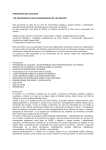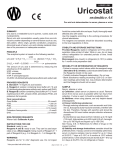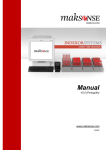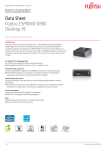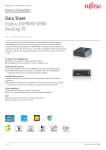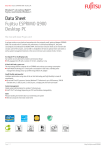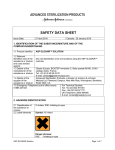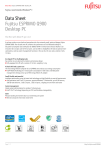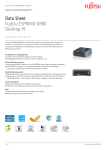Download ALP 405 - Wiener lab.
Transcript
LIQUID LINE ALP 405 C AA Optimized kinetic method at 405 nm (DGKC and SSCC) for the determination of alkaline phosphatase SUMMARY Alkaline phosphatase is an enzyme widely distributed in the body. It hydrolyzes monoesters of orthophosphoric acid in alkaline medium. In adults it comes in part from the liver (thermostable fraction) and in part from the bone, RES and vascular system (thermolabile fraction), yielding different isoenzymes. Serum activity of bone alkaline phosphatase, under normal conditions, reaches maximum levels in children during growth (up to three times adult’s values) since this isoenzyme is found in osteoblasts (related to calcification and bone-formation). The increase produced at the end of the first trimester of pregnancy is also physiologic, at the expense of the placental isoenzyme which reaches its highest levels during this period (about two times over normal levels). Pathologies affecting alkaline phosphatase serum activity include: metastatic carcinomas in bone and liver (enzyme producers), biliary cholestasis, osteoblastic phenomena, malabsorption disorders with ulcerous lesions (where vitamin D deficiency produces osteomalacia leading to increase of bone alkaline phosphatase) and lesions in process of cure such as acute myocardial infarction, lung or kidney infarction. PRINCIPLE Alkaline phosphatase (ALP or orthophosphoric monoester phosphohydrolase - EC 3.1.3.1.) hydrolyzes colorless pnitrophenylphosphate (pNPP) producing phosphate and p-nitrophenol at alkaline pH. The speed at which the pnitrophenolate anion (yellow) appears, read at 405 nm, is directly proportional to the enzymatic activity of the sample. PROVIDED REAGENTS A. Reagent A: DEA (diethanolamine) buffer solution, containing magnesium salts. B. Reagent B: solution containing p-nitrophenyl phosphate (p-NPP). INSTABILITY OR DETERIORATION OF REAGENTS Suspect deterioration of Monoreagent (premixed) if absorbance readings are higher than 0.900 O.D. after setting the instrument to zero with distilled water. WARNINGS Reagents are for “in vitro” diagnostic use. Use the reagents according to the working procedures for clinical laboratories. The reagents and samples should be discarded according to the local regulations in force. STABILITY AND STORAGE INSTRUCTIONS Provided Reagents: stable in refrigerator (2-10oC) until the expiration date shown on the box. Once opened, they should not remain uncapped and outside the refrigerator for long periods. Avoid contamination. Monoreagent (premixed): stable for 1 month in refrigerator (2-10oC) from preparation date. SAMPLE Serum or plasma a) Collection: obtain serum in the usual way. b) Additives: if plasma is used as sample, use heparin as anticoagulant. c) Known interfering substances: - No interferences are observed by: bilirubin up to 16 mg/dl, lipid up to 1000 mg/dl triglycerides, nor heparin up to 50 U/l. - Mild hemolysis (up to 200 mg/dl) do not interfere, but strong hemolysis produce erroneous results. See Young, D.S. in References for effect of drugs on the present method. d) Stability and storage instructions: use preferably fresh serum. If assay is not performed within 6 hours after collection, samples should be kept frozen. Final concentrations DEA........................................................................ 1.0 mol/l Mg....................................................................... 0.5 mmol/l p-NPP................................................................... 10 mmol/l REQUIRED MATERIAL (non-provided) - Spectrophotometer. - Micropipettes and pipettes to measure stated volumes. - Spectrophotometric square cuvettes. - Water bath at selected reaction temperature. - Stopwatch. INSTRUCTIONS FOR USE Provided Reagent: ready to use. They may be used separately or as Monoreagent, mixing 4 parts of Reagent A with 1 part of Reagent B (e.g. 4 ml Reagent A + 1 ml Reagent B). ASSAY CONDITIONS - Wavelength: 405 nm - Reaction temperature: 25, 30 or 37oC. See the REFERENCE VALUES corresponding to each temperature. - Reaction time: 3 minutes and 20 seconds. 864119522 / 01 p. 7/9 - Sample volume: 10 ul Sample and Reagent volumes may be proportionally changed, without altering calculation factors. PROCEDURE I MONOREAGENT TECHNIQUE In a cuvette kept at the selected reaction temperature, place: Monoreagent 30oC 37oC up to 400 up to 450 up to 645 IFCC recommends that each laboratory set its own reference values, selecting groups of people based upon established criteria, according to its own population. PROCEDURE II SEPARATE REAGENTS TECHNIQUE In a cuvette kept at the selected reaction temperature, place: Reagent A 1.0 ml Sample 10 ul Pre-incubate a few minutes. Then, add: 0.25 ml Mix immediately and simultaneously start stopwatch. Read initial absorbance after 20 seconds. Record absorbance 1, 2 and 3 minutes after first reading. Determine average change of absorbance/min (∆A/min), subtracting each reading from the previous one and averaging values. Use this mean for calculations. CALCULATIONS Alkaline Phosphatase (U/l) at 405 nm = ∆A/min x 6,812 QUALITY CONTROL METHOD Each time the test is performed, analyze two levels of a quality control material (Standatrol S-E 2 niveles) with known alkaline phosphatase activity. REFERENCE VALUES The following range of values was observed in normal adults (aged 20-60): Adults (U/l) 25oC 10 ul CALCULATIONS Alkaline Phosphatase (U/l) at 405 nm = ∆A/min x 5,460 Temperature Temperature Children and adolescents (U/l) Mix immediately and simultaneously start stopwatch. Read initial absorbance after 20 seconds. Record absorbance 1, 2 and 3 minutes after first reading. Determine average change of absorbance/min (∆A/min), subtracting each reading from the previous one and averaging values. Use this mean for calculations. Reagent B 1.0 ml Pre-incubate a few minutes. Then, add: Sample As a result of the osteoclastic process, bone isoenzyme increases during childhood and adolescence (up to 18 years approximately), yielding higher alkaline phosphatase levels than in adults. The following table shows extremes values found under normal circumstances: 25oC 30oC 37oC 40-190 45-213 65-300 SI SYSTEM UNITS CONVERSION ALP (U/l) x 0.017 = ALP (ukat/l) PROCEDURE LIMITATIONS See Known interfering substances under SAMPLE. Common anticoagulants (such as disodium EDTA, oxalate, citrate or fluoride) inhibit alkaline phosphatase activity. The reagent may be colored in presence of cleaning solution traces composed of hypochlorite. When using the automatic technique, make sure to rinse all the material that may be in contact with hypochlorite with plenty of demineralized water, including needles and autoanalyzer connectors. PERFORMANCE The assays were performed in an Express Plus analyzer(*). a) Reproducibility: precision studies were performed following the guidelines contained in CLSI (EX-NCCLS) document EP5-A: Intra-assay precision Level 119 U/l 347 U/l S.D. ± 2.6 U/l ± 2.6 U/l C.V. 2.2 % 0.7 % S.D. ± 2.9 U/l ± 3.2 U/l C.V. 2.4 % 0.9 % Total precision Level 119 U/l 347 U/l b) Linearity: reaction is linear up to 1,500 U/l. For higher values repeat testing, previous to serum dilution 1/5 or 1/10 with saline solution. Correct calculations multiplying by dilution factor used. c) Detection limit: the minimum detectable change of ALP activity will be 18 U/l. PARAMETERS FOR AUTOANALYZERS For programming instructions check the user’s manual of the autoanalyzer in use. WIENER LAB PROVIDES Kit for 100 ml (Cat. Nr. 1361402) containing: - 4 x 20 ml Reagent A - 1 x 20 ml Reagent B 864119522 / 01 p. 8/9 Kit for 100 ml (Cat. Nr. 1009241) containing: - 4 x 20 ml Reagent A - 1 x 20 ml Reagent B SYMBOLS The following symbols are used in packaging for Wiener lab. diagnostic reagents kits. Kit for 125 ml (Cat. Nr. 1009301) containing: - 5 x 20 ml Reagent A - 2 x 12,5 ml Reagent B C Kit for 200 ml (Cat. Nr. 1361403) containing: - 4 x 40 ml Reagent A - 1 x 40 ml Reagent B V "In vitro" diagnostic medical device X Contains sufficient for <n> tests H Use by l Temperature limitation (store at) Do not freeze F Biological risks This product fulfills the requirements of the European Directive 98/79 EC for "in vitro" diagnostic medical devices P Authorized representative in the European Community Kit for 200 ml (Cat. Nr. 1009602) containing: - 8 x 20 ml Reagent A - 2 x 20 ml Reagent B REFERENCES - Bessey, O.A.; Lowry, O.H. y Brock, M. - J. Biol. Chem. 164, 231 (1946). - Bowers, G.N. Jr. and Mc Comb, R.B. - Clin. Chem. 12:70 (1966). - Mc Comb, R.B.; Bowers, G.N. Jr - Clin. Chem. 18/2:97 (1972). - D.G.K.C. - Z. Clin. Chem. u. Klin. Biochem. 8:658 (1970); 9: 464 (1971); 10:182 (1972). - S.S.C.C. - Scand. J. Clin. Lab. Invest. 33/4:291 (1974). - I.F.C.C. - Clin. Chem. 22/3: 384 (1976). - International Union of Biochemistry Nomenclature Committee - Clin. Chim. Acta 96/1-2:157 (1979). - Young, D.S. - "Effects of Drugs on Clinical Laboratory Tests", AACC Press, 4th ed., 2001. - I.F.C.C. - Clin. Chim. Acta 87/3:459F (1978). - Demaría, I.; Setta, F.; Lorenzo, L. - Rev. Asoc. Bioq. Arg. 54/3 (1990). - Schlebusch, H.; Rick, W.; Lang, H. and Knedel, M. - Dtsch. Med. Wschr. 99:765 (1974). - Rick, W. - Klinische Chemie und Mikroskopie, p.294, 6th ed., Springer Verlag, Berlin (1990). - NCCLS document "Evaluation of Precision Performance of Clinical Chemistry Devices", EP5-A (1999). - NCCLS document "Evaluation of Linearity of Quantitative Analytical Methods", EP5-A (1986). Volume after reconstitution Cont. Contents g Batch code M Manufactured by: Xn Harmful Corrosive / Caustic Xi i Calibr. b b c h Irritant Consult instructions for use Calibrator Control Positive Control Negative Control Catalog number M Wiener Laboratorios S.A.I.C. Riobamba 2944 2000 - Rosario - Argentina http://www.wiener-lab.com.ar Dir. Téc.: Viviana E. Cétola Bioquímica A.N.M.A.T. Registered product Cert. Nº: 4386/01 864119522 / 01 p. 9/9 Wiener lab. 2000 Rosario - Argentina UR120830



